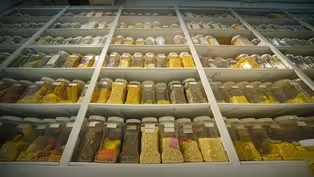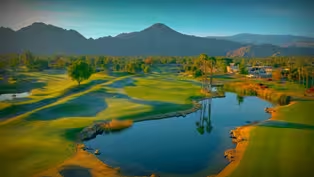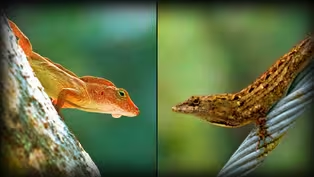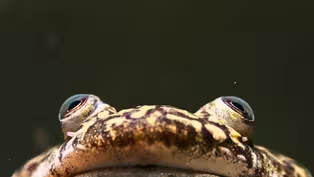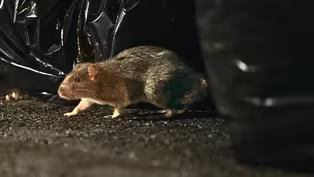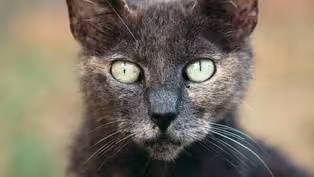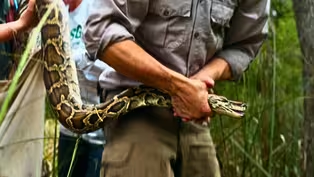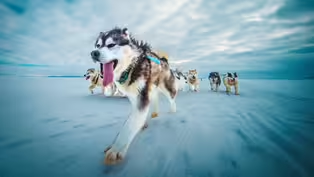
Secrets of the World’s Only Whale Warehouse
Special | 9m 58sVideo has Closed Captions
Uncover the history of whaling and its impact on our oceans.
Long before the days of fast-fashion and chain restaurants, humans were busy hunting down whales and nearly wiping them out – yikes! The efficiency of 20th-century whaling had a devastating impact. Join host Shane Campbell-Staton as he visits Paleontologist Nick Pyenson at Smithsonian's Whale Warehouse to uncover the history of whaling and its impact on our oceans.
Problems playing video? | Closed Captioning Feedback
Problems playing video? | Closed Captioning Feedback

Secrets of the World’s Only Whale Warehouse
Special | 9m 58sVideo has Closed Captions
Long before the days of fast-fashion and chain restaurants, humans were busy hunting down whales and nearly wiping them out – yikes! The efficiency of 20th-century whaling had a devastating impact. Join host Shane Campbell-Staton as he visits Paleontologist Nick Pyenson at Smithsonian's Whale Warehouse to uncover the history of whaling and its impact on our oceans.
Problems playing video? | Closed Captioning Feedback
How to Watch Human Footprint
Human Footprint is available to stream on pbs.org and the free PBS App, available on iPhone, Apple TV, Android TV, Android smartphones, Amazon Fire TV, Amazon Fire Tablet, Roku, Samsung Smart TV, and Vizio.
Buy Now

Surprising Moments from Human Footprint
Do you think you know what it means to be human? In Human Footprint, Biologist Shane Campbell-Staton asks us all to think again. As he discovers, the story of our impact on the world around us is more complicated — and much more surprising — than you might realize.Providing Support for PBS.org
Learn Moreabout PBS online sponsorshipMore from This Collection
Human Footprint is a show that delves into the impact of humans on the planet. Join Shane as he travels from farms to restaurants, from high-tech labs to street markets, and from forests to cities to uncover the consequences of our unique history. Are you ready to explore our past, present, and future as a species?
Video has Closed Captions
Watch the rise of a productive crop that has managed to replace itself, but at what cost? (11m 24s)
The Watery Price Of Golf Courses & Lawns
Video has Closed Captions
The cultural and resource costs for manicured lawns and golf courses are quite shocking. (11m 29s)
How Dogs Are Shaping The Future Of Medicine
Video has Closed Captions
Observe the rich diversity of dog breeds, shaped by genes and human intervention. (12m 43s)
We Brought This Fish To America. Now We Can't Get Rid Of It
Video has Closed Captions
Expose Asian carp for disrupting native fish species and shrinking their populations. (10m 39s)
Why Are These Urban Lizards Evolving in Overdrive?
Video has Closed Captions
Examine city-dwelling anoles with remarkable evolutionary changes. (10m 33s)
How An Ancient Ocean Shaped Us History
Video has Closed Captions
Learn how millions of years of deposits shaped the events of Black American history. (16m 54s)
Video has Closed Captions
What happens when frogs become indispensable? (8m 59s)
Video has Closed Captions
When it comes to NYC, the rat is the undisputed king! (13m 26s)
Your Cat’s Secret Life (as a Deadly Predator)
Video has Closed Captions
Cats have been winning the hearts of humans for years....but can devastate ecosystems. (10m 40s)
Singapore: Designing a Megacity in Harmony with Nature
Video has Closed Captions
Green spaces aren't just an afterthought here - they're mandatory! (13m 24s)
How Giant Pythons Became Florida’s Biggest Invasive Species
Video has Closed Captions
Ever heard of the phrase "when pet pythons outgrow their owners"? (13m 24s)
Sled Dogs: The Most Extreme Distance Athletes on Earth
Video has Closed Captions
In the Arctic, it's not just about muscle power, but brainpower too. (15m 17s)
Providing Support for PBS.org
Learn Moreabout PBS online sponsorshipWhat happens when you remove two to three million whales…in a very short period of time?
If you lived in New England in the mid-to-late 19th century, chances are the flames lighting your home, just like the ones guiding ships back to shore, were powered by whale oil.
And our mass consumption of these gigantic mammals didn’t just change our lives - it altered the makeup of the entire oceans.
How could just a few decades of human exploitation have such a global impact?
That’s what I wanted to know, and how I ended up in one of the strangest places I’ve ever visited.
I’m Shane Campbell-Staton, and this is Human Footprint.
Welcome to the Land of Giants here.
Wow.
Aw, see hell to the yeah, this is crazy.
How many whales do you have here?
We have every species that's on the planet represented in our collection.
Nick Pyenson is a biologist who studies ancient whales, so he spends a lot of time with fossils that are tens of millions of years old.
But he’s no stranger to living whales, either.
If there's a question about whale diversity and evolution, you can probably find an answer with one of these specimens.
This is Nick’s happy place: a Smithsonian storage facility in Maryland he calls “The Whale Warehouse.” I know every collection has its unique smell.
But what the hell is it that I'm smelling right now?
So you're smelling whale oil just everywhere and it's whale oil that's hundreds of years old that still hasn't really leached out of the bones.
Seeping out of the bones now.
Yeah.
Let me have you take a deep whiff of this one over here.
Oh man, you just get way up in there.
Well, it's biology.
You got to get… All up in the business.
Alright let’s… yeah, oh God yeah.
So I have my own way of describing that.
… It feels like knowledge to me, but maybe to you it’s just death warmed over.
There's basically, there's knowledge in the stank is what you're saying?
I might borrow that in the future.
So why is it like that?
Well, these animals have blubber in life.
Fat is really important for sustaining themselves.
These animals live in very large environments where their food is patchy.
You need to have a lot of fat reserves to make it so that, you don't eat every day.
But when you do eat, you just feast, store it and then end up migrating sometimes really, really far.
So fat is a really important part of their life history and it ends up in their bones all around their bodies.
Okay.
So they're not just big boned is what you're saying?
That's a really good way of putting it.
Now I’ve seen a lot of biological specimens in a lot of museum collections, but nothing like this.
So here are the jaw bones - What the hell?
These are the jaw bones of a blue whale.
Bruh.
This is ridiculous.
Inside are the jaw bones of a bull sperm whale that was 60 feet long.
The owner of the blue whale jaw bones was 92 feet long.
Whoa.
And here's the crazy thing.
You are looking at the largest single bone in the history of life.
There is no dinosaur bone, mammoth tusk, nothing is as big as this bone.
Wow.
So this is it.
And we'll never collect something like this again.
These are blue whales from the southern ocean.
And this was collected at a time when there was still a lot of whaling going on, especially in that part of the world where some two to 3 million whales were killed.
… This was one of them.
Even the biggest animals that ever lived aren’t off limits for the planet’s Top Predator.
But why?
I mean, there’s got to be an easier way to eat.
So, here we have a gray whale skeleton that's at least 1000 years old and it's from the coast of North Carolina.
And I can show you right here, you have these nice butchery marks right there.
Our ancestors in the human lineage were using stranded whales as a resource either for meat, maybe for the bones.
But at some point, stranded whales weren’t enough any more.
So at some point there's like two dudes sitting on the beach and one turns to the other.
It's like, oh man, you see that gargantuan thing out there?
Let's go get it.
Bet money I can kill it.
I think that bet probably ended badly most of the time.
The technology to actually have a successful hunt really didn't come together until about 1000 years ago.
And the purpose of that hunting, was it for food or other purposes?
For mostly not for food, but for oil.
Whale oil was really, really good.
Great lubricant, burned really cleanly… Whale oil lit New England in the middle to late 19th century.
And it was only with the discovery of actual petroleum, oil from the ground where it no longer made economic sense.
The efficiency of 20th-century whaling had a devastating impact.
We didn’t actually know how many whales there were in the world’s oceans, so why did it matter?
There was just no limits.
There were so many whales in the Southern Ocean, why not?
So, by the U.S. Marine Mammal Protection Act in 1972, 99% of the blue whales that were alive in 1900 were gone.
How do we know that number specifically?
Whaling is an industry that kept logs and data.
There are 37 volumes like this and they all have page after page after page of individual whale.
And when it was killed, the whale number, male, female and measurements of its carcass… Flipping through these pages is almost like watching whales disappear all over again.
People guess that it's in maybe the few 100s.
600, 800 blue whales globally made it through the 20th century.
It turns out that these ocean giants have a massive role to play in ocean ecosystems.
You could add up the biomass of all the wild mammals on the planet today.
… Just think about tigers, lions, elephants, all the wild mammals on the planet.
The level of biomass of whales before industrial whaling was some two, maybe three times as large as that.
So, the number of whales that were removed... Just in a few decades, not even in 100 years.
Was two to three times the total biomass of all wild mammals that exist on this planet today?
And it’s not just the whales themselves that the ocean lost, but all the things they did… Like eat.
So, here's a jar of krill.
Okay.
And this is the stuff that giants are made of.
Exactly.
Yeah.
It's a really good way of putting it.
And in the southern ocean there's more krill than basically anything else.
So in a geological sense, the age of ocean giants is still young… but we already came close to ending it.
So if the giants are gone, are our oceans just stocked full of krill now?
Yeah, so, that's the krill paradox, right?
Removal of whales... Is that what it's actually called?
That’s what it's actually called in literature.
That's what people have been calling that for decades.
The krill paradox.
Wow.
That'd be a great band name.
Yeah.
So, the krill paradox is that with the removal of whales, you expect … there'd be so much more krill, turns out that's not the case.
Krill have actually dropped in numbers.
How does that work?
Well, so there's a feedback loop here, and it goes back to whales feeding and then pooping in the upper layers of the water column right in the photic zone.
The “photic zone” is the layer of water near the ocean’s surface where light can penetrate and plant life can grow.
Whales spend a lot of time deep underwater, but they have to surface to breathe… and it turns out, that’s where they do most of their pooping, too.
So, when whales aren't there, they are not fertilizing the oceans as much as they otherwise would be.
They're mobilizing nutrients.
So, that includes phosphorus or nitrogen… And phytoplankton, zooplankton, like krill – they're going to need these nutrients to build these incredibly productive, healthy, food webs.
So whales are dependent on the krill, but the krill are also dependent on the whales.
Whales are essentially, kind of in a way, farming krill with their poop.
And that's why we call them ecosystem engineers.
The chemistry of the oceans, too, changed with the removal of all those whales.
Wow.
I think it's a source of wonder to live alongside some of the largest species, not just on the planet right now, but to have ever evolved in the history of life on this planet.
How lucky are we?
And we nearly snuffed them out.
Now the fortunate thing is they didn't go extinct.
… So, I kind of think we have a second chance in the 21st century to make a greater impact.
Thanks for watching!
If you want more Human Footprint, you can tune in to the full length series on the PBS App or on your local PBS station.
Check out the link in the description to watch a full episode and to find out more about the show.

- Science and Nature

Explore scientific discoveries on television's most acclaimed science documentary series.

- Science and Nature

Capturing the splendor of the natural world, from the African plains to the Antarctic ice.












Support for PBS provided by:
